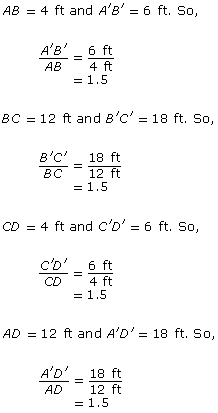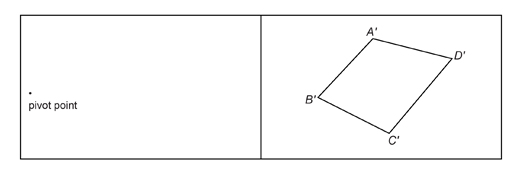Module 6
1. Module 6
1.4. Page 4
Module 6: Triangles and Other Polygons
Bringing Ideas Together
In the Explore section, you investigated similar polygons by changing the grid size upon which the polygons were drawn. You discovered that for those polygons, the corresponding angles were congruent—equal in measure. You also observed that the ratios of the corresponding sides are all equal and determined by the scale factor. Now it is time to see how these similar polygon relationships can be useful in solving problems.
Example 1
Jasmine is designing a rectangular patio for her neighbour. She has shown her neighbour two sketches. The sketches ABCD and  are similar in shape but differ in size.
are similar in shape but differ in size.

- Are the corresponding angles congruent?
- Determine the ratios of the lengths of the corresponding sides. Are the ratios equal?
- What scale factor did Jasmine use to draw

- How are the answers to question parts b and c related?
Solution
-
All angles in the rectangles are right angles and are equal in measure.

The corresponding angles are congruent.
- Note: Use AB as the symbol for the length of side AB.

All the ratios are equal to 1.5.
- Jasmine used the scale factor 1.5 to draw
 She multiplied both the length and width of ABCD by 1.5 to draw
She multiplied both the length and width of ABCD by 1.5 to draw 
The length of rectangle ABCD is 12 ft.
The width of rectangle ABCD is 4 ft.
- The scale factor is equal to the ratios of the corresponding sides of the similar figures.
Proportional Reasoning
In the previous example, the ratios of corresponding sides are equal.
proportion: a statement showing two ratios are equal
![]()
If the ratios of the sides of two polygons are equal, the sides of the two polygons are said to be proportional.
In the next example and in the follow-up question in the Lesson 1 Assignment, you will investigate another method of drawing similar polygons. You will also determine if the sides are proportional and if the corresponding angles are congruent—equal in measure.
You will need two sheets of blank paper, two elastic bands, tape, a ruler, a protractor, and your calculator. Work with a partner, if possible.
Example 2
Use two elastic bands to draw a figure similar to quadrilateral ABCD.

Or you can print “Quad ABCD Diagram” for a copy of the quadrilateral ABCD and pivot point shown above.
Solution
Step 1: Tape the diagram you printed and a blank sheet of paper beside each other, as shown, on the top of a desk or table. Use masking tape so you do not damage the surface of the table or desk.

Step 2: Tie two elastic bands together. If the bands are the same size, each must be shorter than the distance from the pivot point to the nearest point on ABCD. If the elastics are different sizes, one must be shorter than the distance from the pivot to ABCD.

Step 3: If you are working with a partner, have your partner hold the end of one elastic band on the pivot point. One method is to ask your partner to insert a pen in the loop of that band and place the tip of the pen on the pivot point. Place the tip of your pen in the other loop and stretch the bands so that the knot is on point A. Mark the point on the second sheet where your pen tip is. Call that point, point  In a similar fashion, locate points
In a similar fashion, locate points  on the second sheet. Join the four points to form
on the second sheet. Join the four points to form 


Save your work in the course folder. You will need your work to answer questions from this example in the Lesson 1 Assignment.
 Mastering Concepts
Mastering Concepts
Suppose you wanted to draw a polygon similar to, but smaller than, a given polygon. How might you use the elastic bands?
Consider a quadrilateral ABCD placed on the right-hand sheet and the pivot point on the left-hand sheet.
